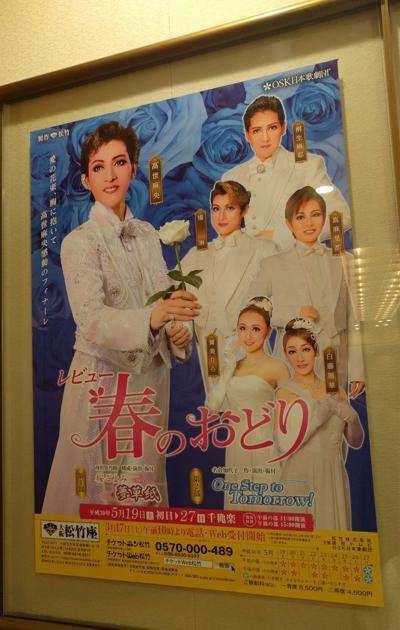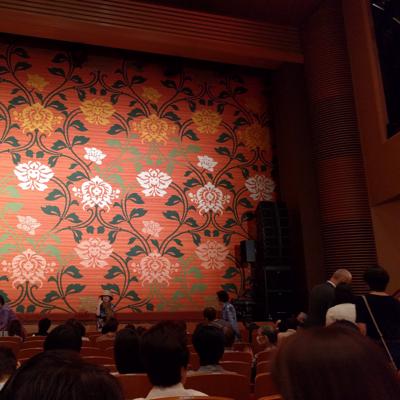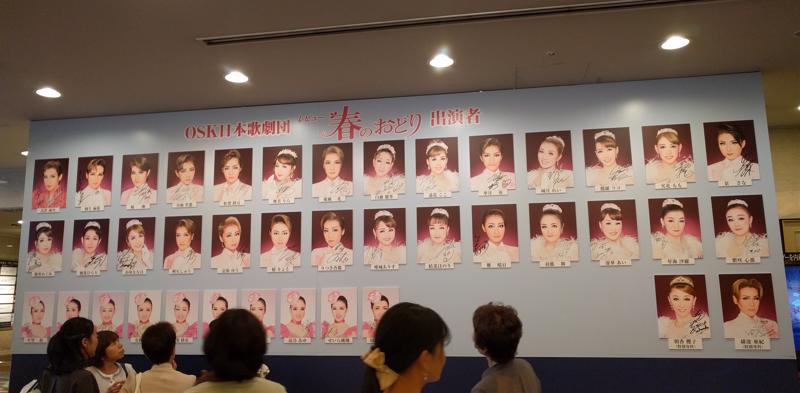Japan, Take 2
I went to see the Osaka equivalent of the Takarazuka Revue (the all female musical theatre production group) to do a compare and contrast.
I can't make a good comparison since the show I saw was not a play-based performance, but a dance-based performance, and I've only ever seen the play-based performances of Takarazuka, but it was still interesting nonetheless.
For starters, they don't have 5 (6?) different troupes of performers, and I have not yet had a chance to confirm this, but I believe there is only one main group, and therefore I saw them. This particular dance show had a first half HEAVILY based on traditional Japanese dance, i.e. Nihon Buyoh, a.k.a. the type of dance I've been studying for the past few years.
They were really good dancers. I recognized a lot of the
May 15-20 竹笋生 Bamboo Shoots Appear
May 21, 2018
|
Osaka
I went to see the Osaka equivalent of the Takarazuka Revue (the all female musical theatre production group) to do a compare and contrast.
I can't make a good comparison since the show I saw was not a play-based performance, but a dance-based performance, and I've only ever seen the play-based performances of Takarazuka, but it was still interesting nonetheless.
For starters, they don't have 5 (6?) different troupes of performers, and I have not yet had a chance to confirm this, but I believe there is only one main group, and therefore I saw them. This particular dance show had a first half HEAVILY based on traditional Japanese dance, i.e. Nihon Buyoh, a.k.a. the type of dance I've been studying for the past few years.
They were really good dancers. I recognized a lot of the

standardized movements (kata), so there was that. The stage was the Shochiku-za in Osaka, so there was not specialized stage like at Takarazuka, and there was not live band. All the music was pre-recorded, and the giant towering speakers flanked the stage. They did incorporate the hanamichi for entrances and exits, which meant that the dances that happened on the hanamichi had to be reversible and visible for audiences on both sides of the walkway, something I did notice they accommodated.
Perhaps because it was their dance show, but there was not a lot of singing from the chorus, and it was mostly pre-recorded vocals on playback.
There was one dance sequence that I really enjoyed, where they had a dancer enter from the hanamichi 7/3 spot, and a screen was flown in that had divided the stage into 3 frames, like a tri-fold mirror. The dancer downstage would dance and move normally, but there were 3 dancers in each of the 3 frames, dancing mirror images of the main downstage dancer, including the tie of their obi knot. So as the main dancer moved left and right, the 3 dancers behind would also move


accordingly, and walk out of "mirror angle" as appropriate. I really liked that.
Another interesting performance of note: they did a piece featuring Youkihi, or Yang Gui Fei, and it was an Otokoyaku who danced her part, instead of a Musumeyaku. Now I'm curious to see a full production of her story. I wonder if it's because her character is such an important part that they'd rather entrust it to a audience-drawing Otokoyaku rather than a Musumeyaku.
The first half of the performance made such an impact on me that I left the venue during intermission to try and find a bank machine so I could grab cash to order the stupid DVD of the performance.
Man, I should really reconsider my research topic b/c this is costing a crap-tonne of cash.
The second half was more western based, and I sadly do mean that literally. Yes, they were dressed in suits and modern dresses for the dances, but there was also the main can-can kick line and they were dressed in "western" fringe-skirts and boots and cowboy hats for

that.
All in all, it was a good experience. Feel no need to pay that kind of money to see it again.
1.
Foreword
2.
72 Seasons of Japan: 雪下出麦 Beneath the Snow the Wheat Sprouts (January 1-5)
3.
Pheasants are like peacocks, right? 雉始雊 The Pheasant's First Calls (January 16-20)
4.
January 21-24 款冬華 The Butterbur flowers
5.
January 25-29 水沢腹堅 Mountain Streams Freeze
6.
January 30-February 3 鶏始乳 The Hens start laying eggs
7.
February 4-8 東風解凍 Spring winds thaw the ice
8.
February 9-13 黄鶯睍睆 The Nightingale Sings
9.
February 14-18 魚上氷 Fish Rise from the Ice
10.
February 19-23 土脉潤起 The Earth becomes Damp
11.
February 24-28 霞始靆 Haze First Covers the Sky
12.
March 1–5 草木萌動 Plants Show First Buds
13.
March 6–10 蟄虫啓戸 Hibernating Creatures Open their Doors
14.
March 11–15 桃始笑 The First Peach Blossoms
15.
March 16–20 菜虫化蝶 Leaf Insects become Butterflies
16.
March 21-25 雀始巣 The Sparrow Builds her Nest
17.
March 26-30 櫻始開 The First Cherry Blossoms
18.
March 31-April 4 雷乃発声 Thunder Raises its Voice
19.
April 5-9 玄鳥至 The Swallows Arrive
20.
April 10-14 鴻雁北 Geese Fly North
21.
April 15-19 虹始見 The First Rainbow Appears
22.
April 20-24 葭始生 The First Reeds Grow
23.
April 25-29 霜止出苗 The Frost Stops; The Rice Grows
24.
April 30- May 4 牡丹華 The Tree Peony Flowers
25.
May 5-9 蛙始鳴 The First Frogs Call
26.
May 10-14 蚯蚓出 The Earth Worms Rise
27.
May 15-20 竹笋生 Bamboo Shoots Appear
28.
May 21-25 蚕起食桑 The Silk Worm Awakes and Eats the Mulberry
29.
May 26-30 紅花栄 The Safflower Blossoms
30.
May 31-June 5 麦秋至 The Time for Wheat
31.
June 5 - June 9 蟷螂生 The Praying Mantis Hatches
32.
June 10 - 15 腐草為螢 Fireflies rise from the Rotten Grass
33.
June 16 - 20 梅子黄 The Plums turn Yellow
34.
June 21 - June 25 乃東枯 The common Self-Heal Dries (Summer Solstice)
35.
June 26 - June 30 菖蒲華 The Iris Flowers
36.
July 1 - July 6 半夏生 The Crow-dipper Sprouts
37.
July 7 - July 11 温風至 Hot Winds Blow
38.
July 12 - July 16 蓮始開 The First Lotus Blossoms
39.
July 17 - July 21 鷹乃学習 The Young Hawk Learns to Fly
40.
July 22 - July 27 桐始結花 The First Paulownia Fruit Ripen
41.
July 28 - Aug 1 土潤溽暑 Damp Earth Humid Heat (Major Heat)
42.
Aug 2 - Aug 6 大雨時行 Heavy Rain Showers
43.
Aug 7 - Aug 11 涼風至 A cool Wind blows (First Autumn)
44.
Aug 12 - Aug 16 寒蝉鳴 The Evening Cicada Sings
45.
Aug 17 - Aug 22 蒙霧升降 Thick Fog Blankets the Sky
46.
Aug 23 - Aug 27 綿柎開 The Cotton Lint Opens (Limit of Heat)
47.
Aug 28 - Sept 1 天地始粛 Earth & Sky Begin to Cool
48.
Sept 2 - Sept 6 禾乃登 The Rice Ripens
49.
Sept 7 - Sept 11 草露白 Dew Glistens White on Grass
50.
Sept 12 - Sept 16 鶺鴒鳴 Wagtails Sing
51.
Sept 17 - Sept 21 玄鳥去 Swallows Leave
52.
Sept 22 - Sept 27 雷乃収声 Thunder Ceases (Autumn Equinox)
53.
Sept 28 - Oct 2 蟄虫坏戸 Insects hole up Underground
54.
Oct 3 - Oct 7 水始涸 Farmers Drain Fields
55.
Oct 8 - Oct 12 鴻雁来 The Geese Arrive
56.
November 19
Share your travel adventures like this!
Create your own travel blog in one step
Share with friends and family to follow your journey
Easy set up, no technical knowledge needed and unlimited storage!